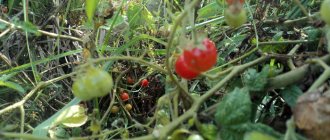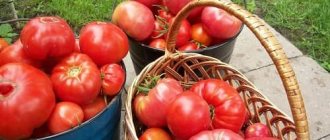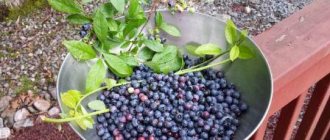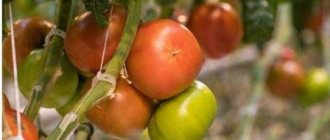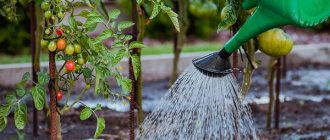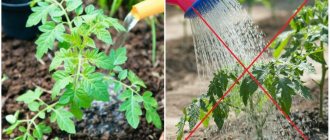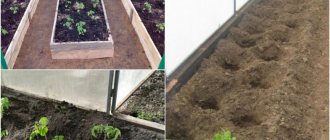How temperature affects tomatoes
The temperature for a tomato should be maintained in the range of 18-28° C. It affects the life of plants, from the moment of emergence to the end of fruiting:
- at 10° C, growth processes stop, the absorption of water and nutrients stops, and adventitious roots do not develop;
- 14° C – phosphorus and nitrogen are not absorbed;
- prolonged cold spell to 14-16° C – the pistil is stretched, the crop must be pollinated by hand;
- in summer, when the heat is 36° C, the pollen becomes sterile, fertilization does not occur;
- at 12°C, the production of lycopene, which turns tomatoes red, stops being produced; they remain yellow.
Optimal temperature conditions after germination
After sowing the seeds, the seedling containers are covered with glass and placed in a warm place. They are ventilated daily and the humidity of the substrate is checked. At the same time, the gardener controls the emergence of seedlings. As soon as the first loop appears, the shelter is removed, the boxes or pots are transferred to a cool place, and 24-hour lighting is provided.
You can’t wait for friendly shoots. The strongest tomatoes hatch first, which, after transplanting into a greenhouse or garden, will produce the largest harvest. But if you keep them warm, they will grow into frail bushes.
Optimal temperature for tomato seedlings in the first week after germination:
- daytime – 14-17° C;
- night – 8-10° C.
Some sources recommend warmer contents - 16-18 and 12-14 ° C, respectively.
Reduced temperature relative to optimal indicators:
- ensures good root development, slowing down the growth of leaf apparatus;
- does not allow the hypocotyledonous knee to stretch;
- reduces the likelihood of blackleg disease;
- increases the resistance of seedlings to negative external influences;
- ensures rapid rooting after picking.
After 5-7 days, you should reduce the illumination to 12-14 hours, and grow tomatoes at a higher temperature. It should be different not only for different times of the day, but also depends on the weather outside. This needs some explanation:
- On a sunny day, the optimal temperature for tomatoes growing on a windowsill is 20-22° C.
- At night, photosynthesis does not occur, and the nutrients accumulated during daylight hours are actively processed. To prevent stretching, the temperature is lowered, but not so much that the seedlings could freeze or stop absorbing phosphorus. It should be at least 14, but not higher than 18 ° C.
- On a cloudy day, seedlings grown without lighting receive little ultraviolet radiation. The temperature is reduced to 17-19° C.
Planting seedlings of early varieties
How to choose the right early tomato? To avoid problems when transplanting seedlings, attention must be paid to the crop variety, because a lot depends on this, even the period of sowing the seeds. Early tomatoes include tomatoes, which can be harvested within 103-107 days after sowing. There are also very early representatives of this crop, that is, the harvest can be obtained in 80-90 days. Before purchasing such tomatoes, it is recommended to carefully study all the features and accurately determine the planting day according to the lunar calendar.
It is recommended to plant seedlings of these varieties of this vegetable crop 1.5 months after the first shoots appear. Before planting in the garden, be sure to pay attention to what the ambient temperature is during the day and night. To prevent seedlings from dying, the average temperature should be at least +12 degrees. Therefore, before sowing, you need to take this fact into account, depending on the weather conditions in each area and possible spring frosts.
When to plant? The optimal time for early tomato varieties is considered to be early to mid-May. If there is still a possibility of frost, then at first the seedlings can be covered with film at night.
Temperature after picking
The temperature for tomato seedlings immediately after picking should be reduced by several degrees (to 17-19° C). This will slightly slow down the growth of the above-ground part, giving the root time to recover from stress.
In the future, the temperature regime for tomato seedlings should be within 18-25° C. It is not always possible to adhere to the optimum of 20-22° C.
If tomatoes grow on a windowsill, the seedlings pressed against the glass may die in frost, even when the thermometer shows more than 20° C in the room. The air temperature inside the room is very different from that of frost-covered or simply very cold glass.
To prevent seedlings from freezing:
- move the tomatoes away from the window;
- protect the seedlings with a screen made of foil, a piece of plywood or polystyrene foam;
- From time to time change the side of the seedling box or rearrange the pot facing the glass.
The soil can also freeze, while the air is warmed up well. To increase the temperature, the tomatoes are placed on a stand - the containers stop touching the cold window sill, and a warm air layer appears between them.
When growing tomato seedlings, heat of 26° C and above is also dangerous. Seedlings should not be placed near radiators. But at home, where there is a battery under every window, this is problematic. You can protect plants by protecting them from heating devices with a foil screen and regularly ventilating the room. Dry tomatoes withstand cold less well.
When cool maintenance is needed
It is not always possible to grow tomatoes without allowing them to stretch. One way to curb growth is to lower the temperature. It’s easier to do this in a greenhouse - you can open the door briefly and quickly bring the air to an acceptable minimum.
In a city apartment, you need to ventilate the room often - create a draft, and cover the tomatoes with newspaper. The night drop is arranged by placing the seedlings on the floor near the slightly open balcony door - there the temperature is lowest.
Temperature when hardening tomatoes
In order for the bushes to quickly take root, adapt to the garden, immediately begin to grow, and get sick less often, they need to be hardened off before replanting. This is especially important when growing in open ground.
Planting tomatoes without adaptation to external conditions is risky - they may die.
The operation takes at least 7 days, but it is better to allocate 10-14 days for it. Hardening should occur smoothly.
Choose a clear day with a temperature of at least 15° C, leave the seedlings on the balcony or street for 20 minutes. The time is gradually increased, and the tomatoes are taken out into the fresh air, regardless of the weather.
For the last 2-3 days, the seedlings should spend the night outside. A minimum temperature of 10° C is acceptable. If a cold snap is expected and the thermometer drops below, the tomatoes are covered with non-woven material and old clothes, but are not brought into the house.
Seedlings undergoing hardening must be watered!
Temperature conditions for growing tomatoes
When you have decided on the variety and bought the seeds, you can begin preparing them for seedlings.
After careful selection, rinse the seeds and leave them overnight in a nutrient solution (it is better to purchase them at a specialty store). After this, in order for the seeds to hatch, they must be placed on a wet cloth, preventing it from drying out. Seeds can begin to germinate at 10C°, but at 20C° this process takes only 3-4 days. Then you should prepare the soil for seed germination. For this, it is best to use wooden boxes. Having spread the seeds to a depth of 1.5 cm at a distance of two centimeters from each other, they are sprinkled with soil, covered and put in a warm place.
At this stage it is very important to monitor the temperature. The temperature should not be less than ten degrees, and ideally should be 16C°. By increasing the temperature to 22-24C°, you will immediately notice that the seedlings begin to grow much faster. To avoid stretching the seedlings and ensure the formation of a strong root system, you need to temporarily reduce the temperature to 14 degrees. Consider the fact that at a temperature of +10C° tomatoes stop growing.
When caring for tomatoes planted in the ground, keep in mind that when the thermometer shows more than thirty or less than +12C°, the plants will quickly stop blooming. Such a high temperature will cause the ovaries to fall off and the pollen to become sterile. And if the temperature remains low, the pollen will not even ripen.
When the temperature drops below five degrees Celsius, or rises above +40, the plant is rapidly damaged and dies in the shortest possible time. And if the level is below 0C°, then the tomato bush is destroyed immediately.
Having considered the influence of different temperature conditions on tomatoes, you can determine what temperature is optimal for them: the daily norm is 20-22C°, the night norm is 16-18C°.
However, the temperature of the soil where the plants develop must also be appropriate, about 22 degrees. If it falls below 15C°, then the roots begin to suffer. It becomes more difficult for the plant to obtain useful fertilizers and water from the soil. And when the temperature drops to +10, the root system loses the ability to receive nutrition.
Minimum temperature in open ground
The seedlings are moved to a permanent place when the ground outside warms up:
- for greenhouses – up to 10° C;
- when grown in open ground - up to 15° C.
Soil temperature can be measured with the cheapest probe thermometer used in cooking. As a last resort, wait until the threat of night frosts has passed and the air outside does not fall below 15 degrees for several days:
- for open ground - at night;
- when planting in greenhouses - during the day.
The minimum temperature for planted seedlings is plus 3° C. They can withstand it for a short time, only a few hours. So in regions with problematic climates, it is recommended to always have a covering material on hand - film, spandbond, agrofibre. And carefully monitor the weather forecast.
Expert website Pomidoroff.ru
Maria Nikolaevna
Experienced vegetable grower, 40 years of experience. Graduated from Michurinsk State Agrarian University (MICHGAU)
Ask a Question
The lowest temperature that well-rooted and renewed growth tomatoes can withstand for several hours is minus 2° C. Siberian varieties are more resistant and can withstand -4° C.
Prolonged cooling down to 10°C stops the growth of tomatoes. The roots stop performing their assigned functions - supplying water to the above-ground part and absorbing nutrients.
If the weather surprises only at night, or turns bad for several days, this may slightly delay the ripening of the fruit. The consequences are minimized by treatment with epin or zircon, and after warming - by unscheduled fertilizing with a complete mineral complex.
Further care
If you properly care for tomatoes immediately after planting, then they will cause a minimum of trouble. And they will give a good harvest.
Cold protection
Even in the south, after planting tomatoes there can be large differences between night and day temperatures. In unfavorable weather conditions, it is recommended to cover the tomatoes in the evening with agrofibre or other non-woven material and remove it in the morning.
In cool regions, when growing crops in the ground, gardeners are forced to build temporary shelters in advance. Otherwise, you will have to change the timing of planting seedlings to a later date. Accordingly, even early varieties may not ripen, since the fruiting time will be shortened.
Mulching
Soil protection retains moisture, prevents the roots from overheating and prevents weed germination. In addition, the lower leaves and shoots of tomatoes will not lie on the ground, which will significantly reduce infection by harmful microorganisms and protect the bushes from pests in the soil.
The following is used as mulch:
- straw;
- hay;
- cut grass;
- dried weeds (not inseminated);
- pine litter;
- dry peat;
- well-rotted sawdust or tyrsa.
Even mature humus contains too much nitrogen. After the apples begin to form, it will only harm the tomatoes, so it is not recommended for use.
The easiest way is to cover the ground with black non-woven material.
It is rarely possible to arrange tomatoes in the beds in the same even rows as in a greenhouse. Holes for seedlings should not be cut in advance. It is recommended to do this:
- After planting the tomatoes, near the center of each bush, stick a cane into the ground slightly larger than the height of the stem.
- Cover the bed with agrofibre or spunbond.
- The sticks will indicate the location of the bushes. This is where you need to cut the holes.
Watering
During planting, the tomatoes received enough moisture to do without watering for the first 2 weeks. There is no need to pay attention to the leaves drooping in the middle of the day.
Of course, sweltering heat can suddenly set in. Therefore, it is recommended to go out into the garden early in the morning and inspect the bushes. If the leaves are straightened, the tomatoes do not need moisture. They should be watered when the plates have not risen overnight.
Read how to water tomatoes in open ground here.
Read about drip irrigation of tomatoes here.
Top dressing
The first foliar feeding is done a week after planting. It should contain all micro- and macroelements. It is recommended to add an additional dose of boric acid to the bottle (1/2 teaspoon per 10 liters of water), plus epin or zircon.
Tomatoes are fertilized at the root 2 weeks after planting. The first time they do this:
- on overgrown tomatoes - with an easily digestible phosphorus-potassium fertilizer, for example, potassium monophosphate or Pekacid;
- Normally developing seedlings are given a complete mineral complex.

